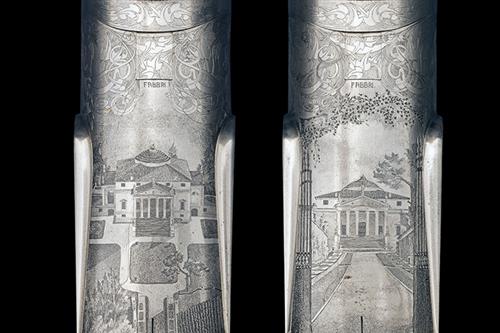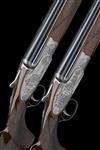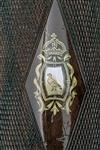Product Details
IVO FABBRI
A FINE PAIR OF TORCOLI-ENGRAVED 12-BORE SINGLE-TRIGGER OVER AND UNDER PINLESS SIDELOCK EJECTOR PIGEON GUNS, serial no. 3505 / 6,
28in. nitro chopperlump barrels with tapered ventilated matt top ribs, gold-inlaid '1' and '2' at the breech ends (no.1 rib with dents), side ribs, over barrels engraved 'VACUUM ARC REMELTING STEEL', 'IVO FABBRI - BRESCIA - ', and gold-inlaid 'CONSTRUITO PER P. BRIGATO', 2 3/4in. chambers, bored approx. 3/4 choke in all, hold-open toplevers gold-inlaid '1' and '2', manual safeties, the actions finely bordered with scrolling art nouveau foliate designs, surrounding extremely fine bulino style depictions of 'Villa La Rotonda' and its surroundings from various angles, each triggerguard engraved with one of the classical style statues that adorn the building, the triggerplates signed 'TORCOLI inc.', 14 3/4in. very highly-figured pistolgrip stocks with palm swells and including 1in. rubber recoil pads, the fore-ends finely inset in gold with ornate armorial crests with a pigeon trussed, weight 7lb. 8oz., in their lightweight leather case with Ivo Fabbri parchment trade label
Provenance: Inspired by the Pantheon in Rome, Villa Almerico Capra Valmarana (popularly referred to as 'Villa La Rotonda') was designed by Andrea Palladio in 1565 for a retired priest, Paolo Almerico on his return from the Vatican. Sited on a hilltop just outside the city of Vicenza, the building is now conserved as part of the World Heritage Site "City of Vicenza and the Palladian Villas of the Veneto".
It was a groundbreaking piece of architecture, the design for a building having a square plan with four facades, each of which has a projecting portico. The whole is contained within an imaginary circle which touches each corner of the building and centres of the porticos. The name La Rotonda refers to the central circular hall with its dome. Each portico has steps leading up, and opens via a small corridor to the circular domed central hall. This and all other rooms were proportioned with mathematical precision according to Palladio's own rules of architecture which he published in the Quattro Libri dell'Architettura.
The design reflected the humanist values of Renaissance architecture. In order for each room to have some sun, the design was rotated 45 degrees from each cardinal point of the compass. Each of the four porticos has pediments graced by statues of classical deities. The pediments were each supported by six Ionic columns. Each portico was flanked by a single window with all the principal rooms on the second floor.
The Villa was designed to be in perfect harmony with the landscape and with symmetry being at the heart of the design. Whilst the house appears to be perfectly symmetrical, it actually has many deviations and variations in the facades, widths of the steps and retaining walls which allows each façade to complement the surrounding topography, thereby creating an illusion of overall equipoise.
Building work began in 1567 under the direction of Andrea Palladio but upon his death in 1580, a second architect, Vincenzo Scamozzi was brought in to see the completion of the project.
Please click HERE to view Terms & Conditions.
Estimate £35,000-45,000
S2







